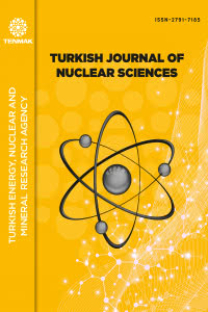TÜRKİYE’DE ŞİŞELENMİŞ MİNERALLİ SULARIN TOPLAM ALFA VE TOPLAM BETA RADYOAKTİVİTE SEVİYELERİNİN BELİRLENMESİ
Bu çalışmada Türkiye’nin çeşitli bölgelerinden ticari olarak şişelenmiş 32 farklı mineralli su numuneleri toplanmıştır. Bu mineralli su numunelerinin toplam alfa ve toplam beta radyoaktiviteleri orantılı sayaçlar kullanılarak ölçülmüştür. 32 farklı numunenin toplam alfa radyoaktivite konsantrasyonu Ölçülebilir Minimum Değer (ÖMD) (0.011-0.681 Bq/L) ile 1.86 Bq/L arasında değişen değerlerde ortalama 0.541 Bq/L olarak tespit edilmiştir. Toplam beta radyoaktivite konsantrasyonu ise ÖMD (0.010-0.245 Bq/L) ile 1.85 Bq/L arasında değişen değerlerde ortalama 0.813 Bq/L olarak tespit edilmiştir. Türkiye’de bulunan mineralli sularda tespit edilen toplam alfa ve toplam beta aktivite değerleri farklı ülkeler için yapılan benzer çalışmalarda bulunan değerler ile karşılaştırılmıştır. Bu çalışmada elde edilen sonuçlara göre toplanan mineralli su numunelerinden bir tanesi hariç diğer tüm numunelerde toplam alfa ve toplam beta aktivite konsantrasyonları Türkiye Sağlık Bakanlığı tarafından yayınlanmış olan yönetmelikteki limitlerin altında kalmıştır. Fakat yine de radyoaktivite açısından güvenli seviyelerin devam ettiğinden emin olabilmek için mineralli suların periyodik olarak izlenmesi gerekmektedir.
Anahtar Kelimeler:
Mineralli sular, Toplam alfa aktivitesi, Toplam beta aktivitesi, Orantılı sayaç
DETERMINATION OF GROSS ALPHA AND GROSS BETA RADIOACTIVITY LEVELS OF BOTTLED MINERAL WATER SAMPLES IN TURKEY
In this study, 32 different commercially bottled mineral waters were collected from various regions of Turkey. Gross alpha and gross beta activities of these bottled mineral water samples were measured by using proportional counters. The gross alpha activity concentrations of 32 samples were determined between Minimum Detectable Activity (MDA) (0.011-0.681 Bq/L) and 1.86 Bq/L with an average value of 0.541 Bq/L. Similarly, the gross beta activity concentrations were determined between MDA (0.010-0.245 Bq/L) and 1.85 Bq/L with an average value of 0.813 Bq/L. The gross alpha and gross beta activities of the mineral waters in Turkey determined in this study were compared with the corresponding values of the different countries. The results of the study showed that the gross alpha and gross beta activities in all collected commercially bottled mineral water samples except one are within the limits of regulations published by Turkish Ministry of Health. Nevertheless, periodic monitoring of the mineral waters is required to ensure the safe level in terms of radioactivity.
___
- 1) Baba, A., Ereeş, F.S., Hiçsönmez, Ü., Çam, S., and Özdilek, H.G., 2008. An assessment of the quality of various bottled mineral water marked in Turkey. Environmental Monitoring and Assessment, Volume 139, Numbers 1-3, 277-285.
- 2) Currie, L.A., 1968. Limits for Qualitative Detection and Quantitative Determination: Application to Radiochemistry. Analytical Chemitry, Vol. 40, No. 3, 586-593.
- 3) Desideri, D., Meli, M.A., Feduzi, L., Roselli, C., Rongoni, A., Saetta, D., 2007. 238U, 234U, 226Ra, 210Po Concentrations of Bottled Mineral Waters in Italy and Their Dose Contribution. J. Environ.Radioctivity, 94, 86–97.
- 4) European Communıtıes (EC), 2007. Natural Mıneral Waters, Spring Waters And Other Waters in Bottles or Containers Regulations, S.I. No. 225.
- 5) Gans, I., 1985 Natural radionuclides in mineral waters. Science of the Total Environment .11/1985; 45:93-9.
- 6) Hem, J.D., 1985. Study and Interpretation of the Chemical Characteristics of Natural Water. 3rd Edition: U.S. Geological Survey Water-Supply Paper 2254, 249 p.
- 7) International Commission on Radiological Protection (ICRP), 1991. Recommendations of the ınternational Commission Radiological Protection on Radiological Protection. ICRP Publication 60. Oxford: Pergamon Pres.
- 8) Jobbágy, V., Kávási, N., Somlai, J., Dombovári, P., Gyöngyösi, Cs., Kovács, T., 2011. Gross alpha and beta activity concentartions in spring waters in Balaton Upland, Hungary. Radiation Measurements (ISSN: 1350-4487) 46: (1) pp. 159-163.
- 9) Kovács T., Bodrogi E., Dombovari P., Somlai J., Nemeth Cs., Capote A., Tarján S., 2004. 238U, 226Ra, 210Po Concentrations of Bottled Mineral Waters in Hungary and Their Committed Effective Dose. Radiation Protection Dosimetry, 108 (2), 175-181.
- 10) Sgorbati, G. and Forte, M., 1997. Determination of 238U and 226Ra concentrations in drinking waters in Lombardia region, Italy. Communication to UNSCEAR Secretariat (UNSCEAR).
- 11) Sidhu, K. S. and Breithart, M. S., 1998. Naturally Occurring Radium-226 and Radium-228 in Water Supplies of Michigan. Bulletin of Environmental Contamination Toxicology 61:722-729.
- 12) Srisuksawad K., Porntepkasemsan B., and Kaewpluck S., 2007. Gross Alpha, Gross beta and Ra -226 Activity Concentrations in Bottled Mineral Waters Sold in Bangkok Metropolitan Area and Their Committed Effective Dose. Thammasat Medical Journal, Jul-Sep (7)(3).
- 13) Şahin, M., Dirican, A. and Şahin, N.K., 2017. Radiochemical separation and determination of radium-228 in bottled mineral waters by low level gamma spectrometry and its committed effective dose. Environmental Earth Sciences, 76:795.
- 14) Turkish Ministry of Health, 2004. Regulation of About Natural Mineral Waters. Offical Gazzette No: 25657.
- 15) United States Environmental Protection Agency, 2002. National primary drinking water regulations, radionuclides, proposed rule. Code of Federal Regulations. Title 40, volume 19.Las Vegas: US. EPA.
- 16) World Health Organization (WHO), 2006. Guideline for Drinking Water Quality.Volume 1: Recommendations,3rd Edition 1st Addendum to vol. 1, Geneva.
- Başlangıç: 1981
- Yayıncı: -
Sayıdaki Diğer Makaleler
Yusuf GÜLAY, Hasan DİKMEN, Çiğdem YILDIZ, Recep BIYIK, Mehmet Timuçin AYBERS
Selen Nimet GÜRBÜZ GÜNER, Erhan AKSU, Haydar DİŞBUDAK, Mahmut EKEN, Ece ERGUN, Yücel Özer ÖZKÖK, Ömer GÜNDÜZ
Mihriban ŞAHİN, Abdullah DİRİCAN, Simay YÜKSEK
NÜKLEER SANTRALLER İÇİN SAHA İÇİ ACİL DURUM PLANLAMA VE MÜDAHALE YAKLAŞIMI
KATIŞKISIZ UO2 YAKIT PELETLERİNİN İLK AŞAMA SİNTERLEME KİNETİĞİNİN İNCELENMESİ
